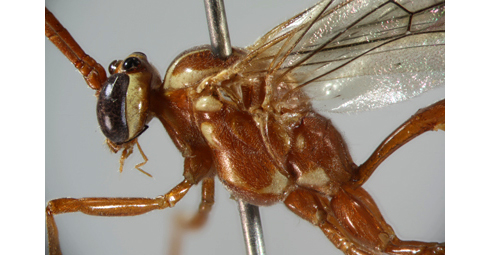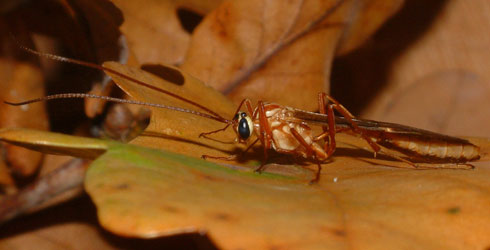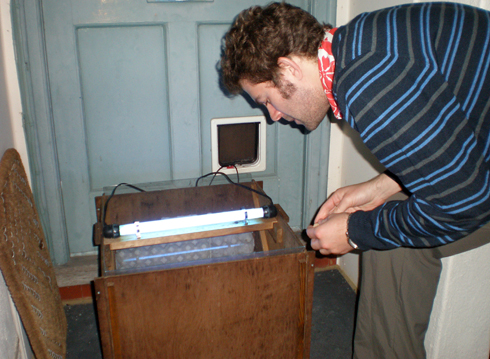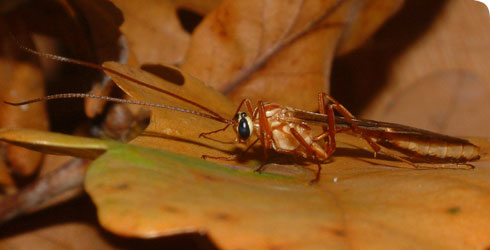Ophion obscuratus
Ophion obscuratus is one of the more conspicuous species of Ichneumonidae, a very species-rich family of parasitoid wasps.
As parasitoids develop, their larvae feed on their host, and eventually kill it. There are around 6,000 species of parasitoid wasps in the UK. Most are parasitoids of other insects such as moths and butterflies - especially their eggs and caterpillars - flies, beetles, greenflies, whiteflies, scale insects and other wasps.
Some parasitoid wasps are used commercially as biological controls of pest species. Importantly, their control is specific, limited to only one or a few species, with most wildlife left unaffected. Encarsia formosa, for example, is used worldwide to control whiteflies, a greenhouse pest that affects many crops.
Species detail
A frequent visitor to light traps, Ophion obscuratus is nocturnal, widespread and frequently abundant.

An adult noctuid moth. Ophion obscuratus is a parasitoid of its larvae.
Like other species of the subfamily Ophioninae, O. obscuratus is an endoparasitoid in the larvae of Lepidoptera. It acts as a koinobiont - the parasitoid larva delays its development until the host larva has reached sufficient size.
Specifically, O. obscuratus is a parasitoid of noctuid moth larvae:
- The adult wasp finds the host larvae at night.
- The host is temporarily paralysed and a single egg laid in the body.
- The parasitoid larva finishes feeding when the host larva is fully grown.
- The wasp larva emerges and pupates, spinning a tough, dark brown, ovoid cocoon of silk in loose soil.
The adult wasps probably feed on nectar.
-

Taxonomy
Read about the taxonomy of Ophion obscuratus and why it is often easier to recognise than other species of Ophion.
-

Distribution
Learn about the distribution and habitat of Ophion obscuratus.
-

References
Get reference material for Ophion obscuratus.
Images

Ophion obscuratus, a parasitoid wasp.

Thorax of the richly marked spring morph of Ophion obscuratus.

Metasoma of Ophion obscuratus (anterior to left).

The nocturnal parasitoid wasp Ophion obscuratus on a leaf.

Dr Gavin Broad, Curator of Hymenoptera at the Museum, setting up a light trap on his front porch.
About the author
Toolbox
Glossary
Endoparasitoid
A parasitoid that develops inside its host.
Koinobiont
A type of parasitoid that allows the host to continue its development (as opposed to preventing any further development of the host, as an idiobiont parasitoid would).
Lepidoptera
A large order of insects that includes moths and butterflies.
Parasitoid
An organism that develops on one host and kills it. In comparison, parasites often jump hosts and rarely kill them.

